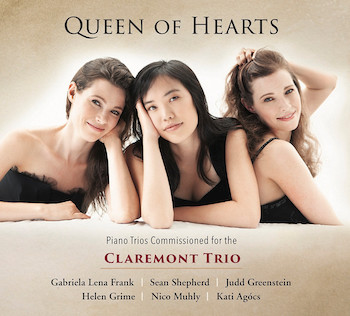Classical Album Review: The Claremont Trio’s “Queen of Hearts”
By Jonathan Blumhofer
What might be the most impressive feature of this disc: everything on it was written for The Claremont Trio since 2008. The album stands as a shining testament to their adeptness as an ensemble as well as their curiosity as musicians.
 The Claremont Trio’s 20th-anniversary release, Queen of Hearts, is a number of things. It’s very well played, for one, and beautifully recorded. The ensemble – violinist Emily Bruskin, cellist Julia Bruskin, and pianist Andrea Lam – is clearly comprised of accomplished individuals who boast an enviable collective rapport.
The Claremont Trio’s 20th-anniversary release, Queen of Hearts, is a number of things. It’s very well played, for one, and beautifully recorded. The ensemble – violinist Emily Bruskin, cellist Julia Bruskin, and pianist Andrea Lam – is clearly comprised of accomplished individuals who boast an enviable collective rapport.
Nor are they shy about commissioning new works. Indeed, that’s maybe the most impressive feature of this disc: everything on it was written for the group since 2008. Stylistically, the six pieces cover a pretty wide range. But they’re tied together by the theme of abstraction.
Sometimes, as in Gabriella Lena Frank’s 2012 Four Folk Songs, it’s broadly familiar musical genres that are getting the treatment. Here, the central movements – “Children’s Dance” and “Serenata,” respectively – most clearly echo the rubric of “folk song”: scamping, repeated cells of tunes in the former, strumming textures imitating guitars in the latter.
Otherwise, the “Canto para La María Angola” and “Chavin de Huantar” aren’t so easily placed. In the first, bold attacks fading into the ether conjure a vision of the eponymous church from afar. Through the other, lyrical figures passed around and building to a dissonant, screaming climax are meant to evoke Peru’s pre-Incan inhabitants.
Sean Shepherd’s Trio, on the other hand, offers no such program. Its three movements vaguely reflect their corresponding titles: “florid hopscotch” offers bouncing rhythms and elaborate figurations tossed between the three players. “Calderwood” – named after the new hall at Boston’s Isabella Stewart Gardner Museum where the Trio was premiered in 2011 – is filled with rising, glassy textures. Ironically, the concluding “slow waltz of the robots” is neither slow nor particularly rigid, but perfectly whimsical.
There’s playfulness – and nostalgia, too – to be had in Judd Greenstein’s A Serious Man. Written in 2013 as a tribute to the composer’s uncle, it’s one of the album’s most clearly diatonic efforts. Reflective, but never saccharine or overdone, A Serious Man is a touching piece – the arpeggios near the end provide a comforting sense of closure – and one that knows just how long it needs to convey a message: not a note is wasted.
Helen Grimes’ Three Whistler Miniatures, in contrast, is less openly personal. A meditation on a triptych of James Whistler images on display at the Gardner Museum (like the Shepherd, these Miniatures were premiered there in 2011), it often pits the string instruments and the piano against one another. This is packed, aphoristic music, highlighted by the bravura angular figurations of the central movement, “Lapis Lazuli.”
While the Grimes takes its cue from visual art, Nico Muhly’s Common Ground is a study of different types of repetition. Hardly a dull or simplistic undertaking, Muhly’s score, composed in 2008, brims with variety: patterns, textures, colors – all all put through their paces. The result is music that unfolds with a high degree of energy (even in the slow-tempo middle part), culminating in a mighty chaconne-like coda.
Filling out the disc is the title track. Written by Kati Agócs in 2017, Queen of Hearts is, like A Serious Man, a substantial, through-composed effort. As in the Muhly, it employs elements of ground bass but also thrives on poignantly chromatic melodic writing. Throughout, Agócs’ ear for dramatic contrasts comes out strongly: Queen’s mix of flowing, impassioned writing and unsettled, troubled textures speak quite strongly.
The performances themselves are all excellent: the Claremonts have obviously invested themselves in this music deeply and play it from a place of deep knowledge and expressive security. As such, the album stands as a shining testament to their adeptness as an ensemble as well as their curiosity as musicians. To be sure, this is a release that makes one excited for the group’s next twenty years.
Jonathan Blumhofer is a composer and violist who has been active in the greater Boston area since 2004. His music has received numerous awards and been performed by various ensembles, including the American Composers Orchestra, Kiev Philharmonic, Camerata Chicago, Xanthos Ensemble, and Juventas New Music Group. Since receiving his doctorate from Boston University in 2010, Jon has taught at Clark University, Worcester Polytechnic Institute, and online for the University of Phoenix, in addition to writing music criticism for the Worcester Telegram & Gazette.
Tagged: Andrea Lam, Emily Bruskin, Julia Bruskin, Queen of Hearts, The Claremont Trio
